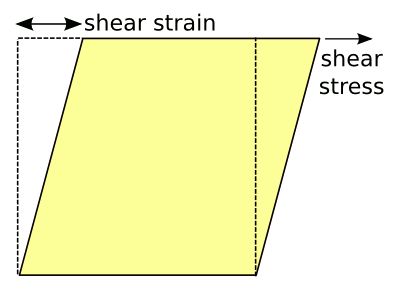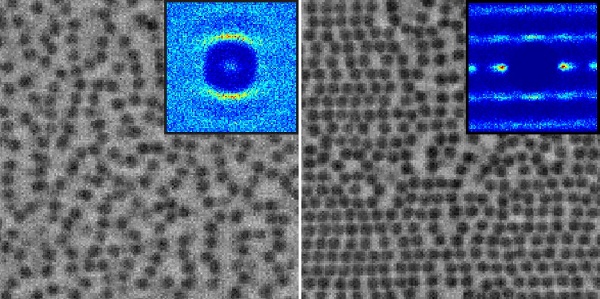Colloidal Shear
January 10, 2012
Shear is an easily understood concept that's known to
mechanical engineers,
physicists,
materials scientists, and all others who work in areas in which the
mechanical deformation of
materials is important. The idea of shear is simply demonstrated in the following figure.

In shear deformation, one boundary is fixed, and the applied force generates a shear strain as shown.
(Illustration by author, rendered using Inkscape))
Shear mechanics applies not only to
solids, but to
fluids as well. A fluid moving in a
pipe, or along a
planar surface, will have zero speed at the surface, and some flow at a point above it. This differential flow can be visualized as a
shear strain, so the fluid has a
shear stress.
If we mix particles into the fluid, we form a
colloid.
Smoke particles in air are often used to visualize flow in
wind tunnels. As can be seen in many
YouTube videos, the smoke particles moving across surfaces behave as you would expect them to, aligning their motion with the prevailing flow.[1-2] If this weren't a property of smoke-air colloids, then smoke in air couldn't be used to visualize flow.
Recent experiments on microscopic spheres in a
viscous fluid by
scientists at
Cornell University and the
University of Chicago show an unexpected shearing behavior in these colloids.[3-4] The research team from the
Laboratory of Atomic and Solid State Physics and
Department of Physics at Cornell, and the
James Franck Institute and
Department of Chemistry of the University of Chicago, found that the spheres form strings aligned perpendicular to the shear.
Said
Aaron Dinner, associate professor in chemistry at the University of Chicago, and a co-author of the study, this experimental finding was "contrary to what many in the field were expecting."[3]
An important part of this experiment was the design of the measurement apparatus.
Itai Cohen, an associate professor of physics at Cornell, built the apparatus that allowed simultaneous application of shearing forces on the colloid and imaging the resulting motion of the spheres.
The imaging was done with
confocal microscopy that allowed planar sections of the colloid to be imaged at a hundred
frames per second. This high imaging rate was important, since the string-like structures appeared only at certain shear rates (see figure).[3]

Confocal microscope images (black/white), along with a visualization of the the degree of alignment (color), for microscopic spheres in a viscous fluid. Left image, no shear, showing random alignment; right image, shear, showing alignment perpendicular to the shear. (Image: Xiang Cheng, Cornell University).
While the shear experiments were done at Cornell by Cohen and postdoctoral associate, Xiang Cheng, making sense of the data was the task assigned to the University of Chicago team of Chemistry professors, Aaron R. Dinner and
Stuart A. Rice, and postdoctoral associate, Xinliang Xu. Xu was responsible for the efficient computer codes that allowed the simulations to run in a reasonable time.[3]
The Chicago team's
computer simulations of the Cornell data showed that
hydrodynamic forces, which are typically ignored in such simulations, were the forces responsible for the formation of the stings. When the microscopic spheres touch, lubrication forces cause them to stick together, and this was the apparent cause for the formation and stability of the strings.[3]
Scientists are making new discoveries as they attain the ability to more closely study
nanoscale systems. These experiments show that hydrodynamics, a field that's hundreds of years old, still has some surprises in store for experimentalists.
As for possible applications, this effect could be used to assemble large-scale particle arrays by shear flow.[4] It might also be possible to form microscopic patterns on
computer chips or
biosensors, and develop paints that flow easily in one direction, but become hard in another direction.[3]
References:
- Mercedes-Benz SLS AMG Development and Testing Wind tunnel, YouTube Video, November 23, 2009.
- Wind Tunnel - MGC Aeronautics' newest acquisition (Airfoil test), YouTube Video, October 13, 2010.
- Steve Koppes, "Shearing triggers odd behavior in microscopic particles," University of Chicago Press Release, December 22, 2011.
- Xiang Chen, Xinliang Xu, Stuart A. Rice, Aaron R. Dinner and Itai Cohen, "Assembly of vorticity-aligned hard-sphere colloidal strings in a simple shear flow," Proceedings of the National Academy of Sciences, December 23, 2011, doi: 10.1073/pnas.1118197108.
- Xiang Cheng, Cornell University, Video: "Microscopic Particles Form Strings." Alternate video on PNAS web site is available here.
- Supporting information for Ref. 4 (PDF File).
Permanent Link to this article
Linked Keywords: Shear; mechanical engineers; physicists; materials scientists; mechanical deformation; material; shear strain; Inkscape; solid; fluid; pipe; planar surface; shear strain; shear stress; colloid; smoke; wind tunnel; YouTube; viscosity; viscous; scientist; Cornell University; University of Chicago; Laboratory of Atomic and Solid State Physics; Department of Physics; James Franck Institute; Department of Chemistry; Aaron Dinner; Itai Cohen; confocal microscopy; frame rate; frames per second; Xiang Cheng; Stuart A. Rice; computer simulation; hydrodynamic; nanoscale; integrated circuit; computer chip; biosensor; Mercedes-Benz; MGC Aeronautics.